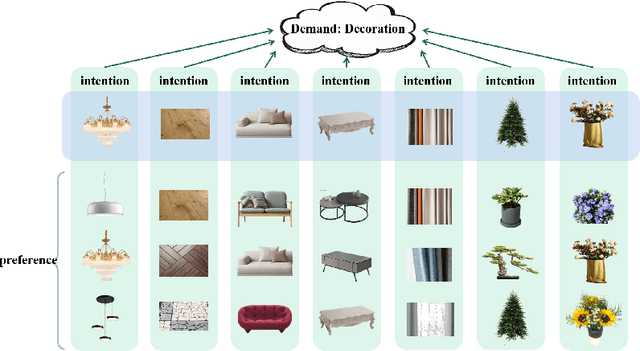Liqi Yang
DAGNN: Demand-aware Graph Neural Networks for Session-based Recommendation
May 30, 2021



Abstract:Session-based recommendations have been widely adopted for various online video and E-commerce Websites. Most existing approaches are intuitively proposed to discover underlying interests or preferences out of the anonymous session data. This apparently ignores the fact these sequential behaviors usually reflect session user's potential demand, i.e., a semantic level factor, and therefore how to estimate underlying demands from a session is challenging. To address aforementioned issue, this paper proposes a demand-aware graph neural networks (DAGNN). Particularly, a demand modeling component is designed to first extract session demand and the underlying multiple demands of each session is estimated using the global demand matrix. Then, the demand-aware graph neural network is designed to extract session demand graph to learn the demand-aware item embedddings for the later recommendations. The mutual information loss is further designed to enhance the quality of the learnt embeddings. Extensive experiments are evaluated on several real-world datasets and the proposed model achieves the SOTA model performance.
RRCN: A Reinforced Random Convolutional Network based Reciprocal Recommendation Approach for Online Dating
Nov 25, 2020



Abstract:Recently, the reciprocal recommendation, especially for online dating applications, has attracted more and more research attention. Different from conventional recommendation problems, the reciprocal recommendation aims to simultaneously best match users' mutual preferences. Intuitively, the mutual preferences might be affected by a few key attributes that users like or dislike. Meanwhile, the interactions between users' attributes and their key attributes are also important for key attributes selection. Motivated by these observations, in this paper we propose a novel reinforced random convolutional network (RRCN) approach for the reciprocal recommendation task. In particular, we technically propose a novel random CNN component that can randomly convolute non-adjacent features to capture their interaction information and learn feature embeddings of key attributes to make the final recommendation. Moreover, we design a reinforcement learning based strategy to integrate with the random CNN component to select salient attributes to form the candidate set of key attributes. We evaluate the proposed RRCN against a number of both baselines and the state-of-the-art approaches on two real-world datasets, and the promising results have demonstrated the superiority of RRCN against the compared approaches in terms of a number of evaluation criteria.
 Add to Chrome
Add to Chrome Add to Firefox
Add to Firefox Add to Edge
Add to Edge